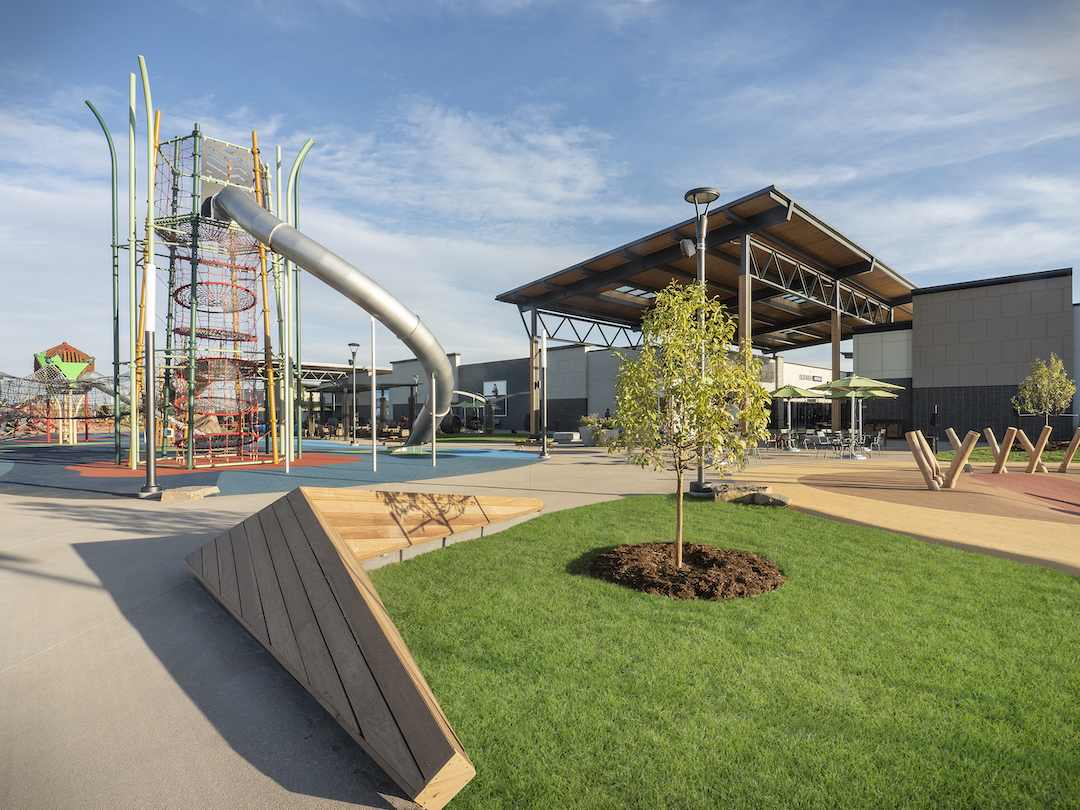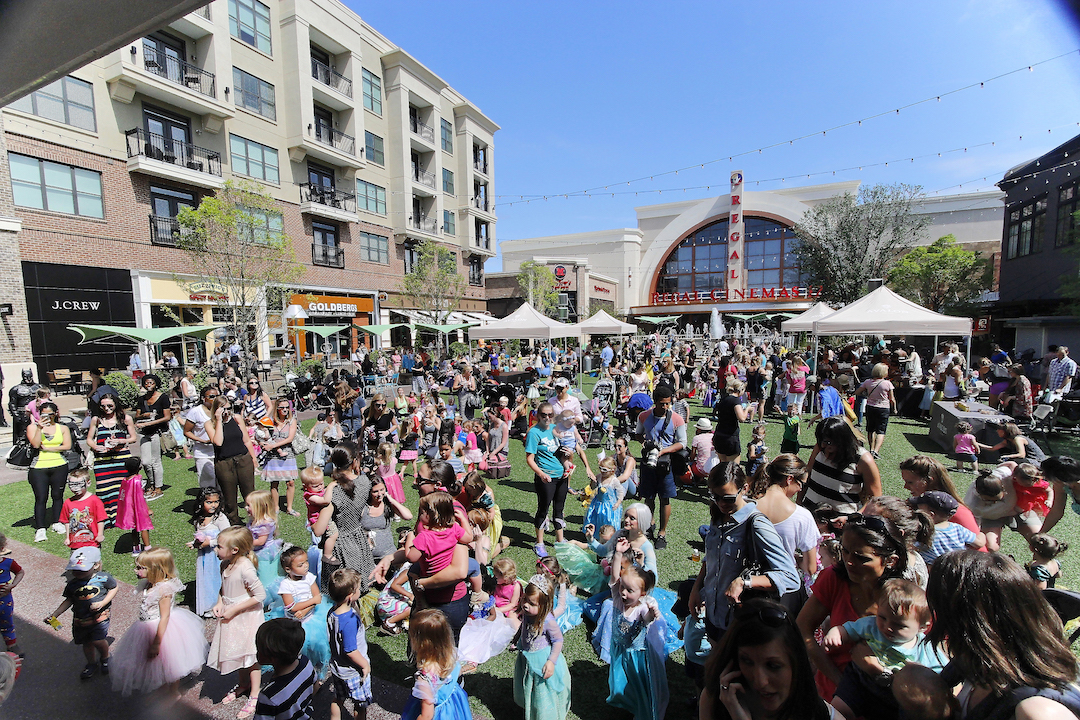While it will always be the tenants that bring traffic to a development, the real challenge for developers is keeping the traffic on-site for an extended period of time, creating opportunities for both cross-shopping and guest engagement.
Increasing dwell time has been a primary focus of developers and tenants alike given the fact that when customers linger, they spend more. According to a study by Path Intelligence, increasing dwell time by just 1% leads to an average 1.3% increase in sales, and for tenants that can add up.
Developers can add value by activating underutilized space to increase guest interaction and introduce programming and placemaking to keep consumers engaged. Building façades, alleyways, and even parking lots (once thought of as dead space) can all be repurposed to not only differentiate your property, but allow for a more memorable connection with guests.
Here are five ways to activate ‘dead space’ in mixed-use developments
1. Celebrate the destination. By understanding the unique location and target consumers, developers can find opportunities to bring a local connection to the forefront. Consumers organically form stronger bonds with destinations they feel they can relate to on a personal level. Developers should leverage this opportunity to identify meaningful symbols or touchpoints that bring the unique community to life.
From commissioning a local artist to activate a parking garage wall, to implementing a regional hobby like cornhole outside a food court, there are opportunities to make a more meaningful connection with local shoppers, so it doesn’t just feel like “a shopping center”—it feels like “their shopping center.”
2. Make space functional. Provide guests with opportunities to become immersed in the experience, through touch, trial, and play. Anytime you can allow for interactive experiences you are no longer offering just products, you are engaging consumers and creating more reasons to visit. For example, turning a building façade into a rock-climbing wall or carving out space for a dog park gives the property robust lifestyle offerings that can benefit both the shopper and the tenants.
A development that offers guests both product and meaningful services is more likely to thrive as some legacy retailers struggle to adapt to the changing industry. Leveraging space for engaging programming, activities, and events will continue to bring guests to your property.

 Arts, entertainment, and placemaking spaces at the Denver Premium Outlets in Thornton, Colo. Photos: Tim O’Hara Photography
Arts, entertainment, and placemaking spaces at the Denver Premium Outlets in Thornton, Colo. Photos: Tim O’Hara Photography
3. Tell the brand story. Walls should never just be walls—they are a foundation to personalize a development and engage your guests in your unique brand story. Your brand can no longer live just on the pylon. There should be touchpoints and winks to the brand throughout the space, from wayfinding to doorknobs. Every inch of your environment is a chance to introduce your brand voice to your guest.
Consider ways to demonstrate your brand through non-graphic/non-obvious decisions, as well. Does your brand have a focus on sustainability? Perhaps you leverage biophilic design to represent this. Are you more about creating community? Consider seating fixtures and furnishings that encourage gathering. By bringing their brand to life, developers have a chance to make a big emotional connection, with a small investment.
4. Leverage the parking lot. With the rise of car-sharing programs, developers will have more open parking space than ever before and should find ways to re-purpose that valuable square footage. Identifying opportunities to better leverage this space, both functionally and aesthetically, is vital.
Create dedicated click-and-collect parking spaces or BOPIS (buy online pickup in store) drive-through lanes to differentiate your development. Store pick-ups accounted for nearly a third of U.S. online sales last November and December, up from 22% just a year earlier, according to GlobalData Retail. These offerings would keep development traffic efficient and customer satisfaction high. And providing experiential offerings—food trucks, farmers markets, movie nights—in overflow parking spaces will keep the experience fresh to increase return visits.
5. Tell the local story. Find the story behind the site and tell it in a meaningful way to further enrich the customer experience. Stories of our history come in various shapes and sizes: notable property owners, history of the town, fun facts, etc.
A recent project in downtown Cincinnati leveraged underutilized sidewalks to tell the region’s rich brewing history through a series of wayfinding and graphic installations. Through rich storytelling and impactful graphics, this urban trail takes visitors and residents alike on a historical journey of adventure and discovery, in an area that was previously undervalued. Developers can take the same approach, identifying underutilized space on their property and bringing it to life by adding a layer of environmental graphics, placemaking, or storytelling.

 The Brewing Heritage Trail in Cincinnati leveraged underutilized sidewalks to tell the region’s rich brewing history through a series of wayfinding and graphic installations. Photos courtesy Prus Construction
The Brewing Heritage Trail in Cincinnati leveraged underutilized sidewalks to tell the region’s rich brewing history through a series of wayfinding and graphic installations. Photos courtesy Prus Construction
From parking lots to branded moments, dog parks to local art, people are seeking new, enjoyable experience. Find those moments of wow that engage customers on a deeper level, creating enjoyment and reasons to come back. Find opportunities to create social media moments, impactful design that people want to share. Most of all, have fun with leftover spaces. Take your guests on unexpected experiences by simply rethinking the space between.
About the Author
John Moores is the Director, Mixed Use with NELSON Worldwide. He provides oversight to meet client objectives nationwide, contributing a decade of expertise in delivering large, complex projects for well-known national brands, such as PNC, Synovus, Whole Foods, and GM. An expert in placemaking, Moores worked on retail, office, hospitality, and residential projects to create community-centered destinations driven by user experience.
NELSON is an award-winning firm delivering architecture, interior design, graphic design, and brand strategy services that transform all dimensions of the human experience, providing our clients with strategic and creative solutions that positively impact their lives and the environments where they work, serve, play, and thrive. Visit www.nelsonworldwide.com to learn more.
Related Stories
| Aug 11, 2010
ASHRAE introduces building energy label prototype
Most of us know the fuel efficiency of our cars, but what about our buildings? ASHRAE is working to change that, moving one step closer today to introducing its building energy labeling program with release of a prototype label at its 2009 Annual Conference in Louisville, Ky.
| Aug 11, 2010
Urban Land Institute honors five 'outstanding' developments in Europe, Middle East, and Africa
Five outstanding developments have been selected as winners of the Urban Land Institute (ULI) 2009 Awards for Excellence: Europe, Middle East, and Africa (EMEA) competition. This year, the competition also included the announcement of two special award winners. The Awards for Excellence competition is widely regarded as the land use industry’s most prestigious recognition program.
| Aug 11, 2010
Cannon Design’s European-inspired Sparkling Hill Resort breaks ground
Cannon Design, a leading international architectural, engineering and planning firm, is pleased to announce that the firm’s Sparkling Hill Resort and Wellness Hotel in Vernon, BC, has broken ground.
| Aug 11, 2010
10 tips for mitigating influenza in buildings
Adopting simple, common-sense measures and proper maintenance protocols can help mitigate the spread of influenza in buildings. In addition, there are system upgrades that can be performed to further mitigate risks. Trane Commercial Systems offers 10 tips to consider during the cold and flu season.
| Aug 11, 2010
Skanska, Turner most active in U.S. hotel construction, according to BD+C's Giants 300 report
A ranking of the Top 50 Hotel Contractors based on Building Design+Construction's 2009 Giants 300 survey. For more Giants 300 rankings, visit http://www.BDCnetwork.com/Giants
| Aug 11, 2010
AECOM, Arup, Gensler most active in commercial building design, according to BD+C's Giants 300 report
A ranking of the Top 100 Commercial Design Firms based on Building Design+Construction's 2009 Giants 300 survey. For more Giants 300 rankings, visit http://www.BDCnetwork.com/Giants
| Aug 11, 2010
New book provides energy efficiency guidance for hotels
Recommendations on achieving 30% energy savings over minimum code requirements are contained in the newly published Advanced Energy Design Guide for Highway Lodging. The energy savings guidance for design of new hotels provides a first step toward achieving a net-zero-energy building.
| Aug 11, 2010
AGC unveils comprehensive plan to revive the construction industry
The Associated General Contractors of America unveiled a new plan today designed to revive the nation’s construction industry. The plan, “Build Now for the Future: A Blueprint for Economic Growth,” is designed to reverse predictions that construction activity will continue to shrink through 2010, crippling broader economic growth.
| Aug 11, 2010
PCL Construction, HITT Contracting among nation's largest commercial building contractors, according to BD+C's Giants 300 report
A ranking of the Top 50 Commercial Contractors based on Building Design+Construction's 2009 Giants 300 survey. For more Giants 300 rankings, visit http://www.BDCnetwork.com/Giants







